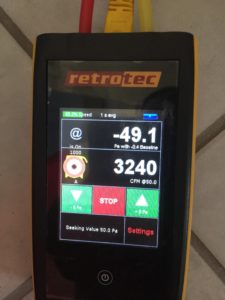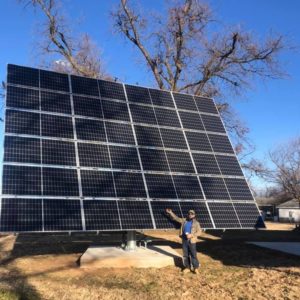I learned a long time ago that the heat and air business is more than just making sure a vent blows hot and cold air. Let’s say, for instance, your air conditioner blows cold air all month in July and at the end of the month you receive a bill from the utility company for $300. Or let’s say your air conditioner blows cold air all month in July and at the end of the month you receive a bill from the utility company for $35. I have found that many customers are only concerned about the vent blowing cold air all month in July and the different values found in the two above mentioned bills are not seen as “a problem”. I believe high utility bills associated with the month to month cost of utilizing an air conditioner or a heater is very important. Almost as important as the HVAC system’s ability to do it’s job. In this blog, I will discuss the importance of developing a plan to incorporate a BPI Energy Analysis, an ACCA Load Calculation and a NABCEP designed renewable energy source for your home.
Many people that show interest in solar energy are not aware of what solar energy actually is. Solar energy is a power plant. Instead of producing enough power to sustain the electric usage of an entire city, solar systems are only able to produce enough power for 1 or 2 homes. If a BPI certified energy analysis is conducted on the homes a solar system serves, and the results of that analysis is implemented to achieve the codes listed in the IECC (International Energy Conservation Code), a solar system can usually power 5-10 homes instead of 1-2. Many people are unaware of what a BPI Energy Analysis actually is. To learn more, read our blog by clicking HERE. If you are within the Morris Heat and Air service territory, you are always welcome to contact us to conduct a BPI Energy Analysis. If you are not within our service territory, you can always check BPI’s website by clicking HERE.

A BPI Energy Analysis is very important because when an energy audit is conducted, the technician can identify the deficiencies found within your home. The main areas of deficiency are inadequate insulation levels in the ceilings, roof decks, and walls, leaky ducts, leaky homes, and improperly sized heating and cooling systems and ducts. Once all deficiencies are identified by way of an energy audit, all revealed deficiencies can be considered and compared to the IECC for repair.
Many duct systems and HVAC systems are found to be inadequately sized when compared to the ACCA Standard of Practice. ACCA has developed the industry standard of HVAC Design in their manuals J, D, QI, Q, and S. ACCA’s Manual J is a residential load calculation manual used to size heaters and air conditioners to maintain the desired setpoint temperature on an extremely cold or hot day based on historical data for the area where the assessment is taking place. For instance, in Tulsa and Okmulgee, we want to maintain an indoor temperature of 70-75 degrees when the temperature outside is 96-103 degrees in the summer and 6-14 degrees in the winter. These parameters may change depending on the geographical location of the area you live in. It is very important to size HVAC Systems correctly. From a code perspective, the Mechanical Code requires all HVAC Systems be installed according to the installation instructions of the equipment being installed. In our Goodman systems, for instance, our high efficiency furnace model GMEC96 says specifically on page 29 of the installation instructions “design the ductwork in accordance with the recommended methods of “Air Conditioner Contractors of America” Manual D. Even Armstrong Air gas packaged units, built by Lennox, states in their installation instructions for their model PRPHP14 Heat Pump on Page 5 “Ductwork” “Ducts should be sized to ACCA Manual Q”. The difference between Manual D and Manual Q is the fittings. Manual D fittings are for residential applications and Manual Q fittings are for commercial applications and Manual Q touches on Fresh Air requirements intended for the use of an economizer that is typically not found on residential applications. My point is that it is very important, from a code perspective, to utilize the ACCA Manuals and size the HVAC System correctly. Its in the installation instructions. A well designed HVAC System will evenly distribute the air throughout your home and will be sized to reduce the humidity level to 40%-60% in your home and use the minimal amount of electricity. I see it over and over again. An HVAC System designed to ACCA’s Standard uses less energy than an HVAC System that is not. Once your home is in order by implementing the BPI and ACCA Standards, you will usually find a drastic change in both the month to month cost of electricity as well as the comfort level of the home. We typically see a 40%-60% reduction in energy usage when we implement the results of a BPI and ACCA Analysis on a home in our service territory. Why would one invest in solar system that produces 17,000 kW per year when they could save 12,000 kW per year by implementing the results of a BPI and ACCA Analysis. To be honest, even after these repairs you will still be paying an electricity bill, but it will be substantially less than what you are used to paying. So by using less energy, you are saving money.
A solar system is used to produce electricity. If a home uses 500 kW per month, you wil need a solar system to produce, at least, that to offset the cost associated with 500kW of electricity. Solar is not always the best thing to invest in. Especially, when your home possesses many deficiencies. I compare it to owning a car with a hole in the gas tank. The car can travel 10 miles after every fill up. So, to make the car go 20 miles per fill up, which costs twice as much, another gas tank is installed. This is the mentality of many people looking to jump into solar. They claim to be using too much energy so the resolve is to produce more energy. If we just fix the hole in the gas tank of the car mentioned above, the car now goes 200 miles per fill up. When a homeowner requests a quote for a solar system, they typically want it on their roof

. I prefer not to install solar systems on roof tops. It will be in the way if there are ever modifications or repairs done on the roof, in rare instances, if a panel catches on fire, it will burn your house down, and the installation costs more considering most of it is done in a location where those installing the panels can hurt themselves if they fall. I prefer to install solar systems on the ground and on a tracking device. When solar is installed on the ground on a racking system it takes up a lot of space and gets in the way of mowing. Typically, you have to weed eat around it. Also, if sitting still, a solar system does not produce as much as it could because it waits for the sun to hit its maximum potential everyday, which only happens for 10 minutes. If the solar array is tracking the sun’s movement rather than sitting still, you get the maximum amount of power production every day. When we install a solar system, everything is on a 10’x10′ concrete pad and at night when it is unused, the array lays flat and turns into a 15′ high canopy. Many people think solar systems take up a lot of space. They do! But, they take up a lot less space when installed on a tracker. A tracker requires less maintenance per year than a combustion engine. I simply grease 14 ports 1 time every year. Once you have a solar system, you and your electric company can enter into an agreement as to how net metering works. Once a net meter is installed, you will reap the benefits of having a solar system. The last 3 solar jobs we did (2 rooftop arrays and 1 tracker) yielded a net electric cost per month of less than $0. This means the customer made money every month after paying their electric bill due to the credits for overproduction.
Once you have an energy efficient home with a solar system, you will begin to save money that was once spent every month on the deficiencies that existed in your home. Back in the 80s, I remember the old saying “Shut the door! We are not trying to cool off the whole world.” When our homes possess deficiencies of leakiness, it is just as bad, if not worse, than cranking up the air conditioner and opening the front door of the home while doing it. Here at Morris Heat and Air, our team can help you identify and repair these deficiencies and ultimately offset what little energy usage you have afterwards with a solar system.

